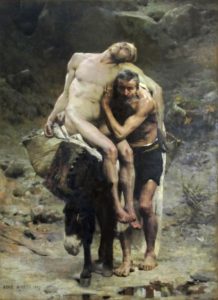 I have spent two days this week unsuccessfully trying to Photoshop the penis of the battered man helped by the Good Samaritan in a piece of art. Oh, the life of a pastor.
I have spent two days this week unsuccessfully trying to Photoshop the penis of the battered man helped by the Good Samaritan in a piece of art. Oh, the life of a pastor.
It’s a beautiful and meaningful piece of art, and our guest preacher for this Sunday asked that I use it as the cover art for our worship folder. Every Sunday, I choose a piece of classical or contemporary art, usually museum-quality paintings, as the cover to our combination order of worship and church newsletter.
This piece, by the 19th-century French painter Aimé Morot, depicts the wounded man stripped naked and draped over the back of a donkey, with the Good Samaritan as an elderly man struggling to hold his charge atop the donkey while slowly walking forward. The image parallels many of the images of Christ’s passion on the cross, particularly those known as “deposition” art, depicting Christ’s removal from the wooden bars. The comparison cannot be missed. The message is powerful.
And yet the man is naked, and we are not in the habit of printing full-frontal male nudity on the cover of the Sunday worship folder, even if dimly lit. So much earnest and comical conversation has ensued this week – not all of it fit for print here. My favorite suggestion was to place an eggplant emoji over the delicate part. That would be culturally relevant and contemporary.
“Might there be a way for art to help us have the conversations we need to have at home and at church?”
The discussion drew me back to my first year on staff at our church, when I worked with a committee to mount our first serious art show during Holy Week. Through a friend in the church, we were able to display a large set of paintings by the American painter Ed Knippers. Some of these paintings were huge – 8 feet tall and 10 feet wide. You couldn’t walk through the room without coming face to face with the content. Others were more traditional-size paintings in frames.
Knippers paints in a baroque style, and for a reason. Showing the biblical characters and especially the Christ figure in the flesh reminds us of the humanity of us all and especially of Christ, who is God yet willingly took on human form. Knippers came to Dallas from Washington, D.C., and gave a lovely talk about the theology of his paintings and why it is important not to deny or overlook Christ’s humanity.
Nevertheless, the first Sunday of that art show turned out to be a three-ring circus. A mother of two younger children called to say she didn’t want her daughters’ first image of a penis to be on Jesus. We had to put up warning signs at both entrances to the gallery space and close the doors. One of our leaders took it upon herself to stand in the parking lot that Sunday morning and shoo parents and children the opposite direction: “Nothing to see here; move along.” And someone – unknown to this day – found a large crimson cloth and draped it over Jesus’ naked body.
That started what I like to call the Great Penis War of ’04.
For everyone who was concerned that children must avert their eyes, there was another person who demanded we not censor art. So the next person came along and in frustration removed the crimson drape from Christ on the cross and accused us all of being prudes.
We had a healthy discussion that Holy Week about art and humanity and the role of the church. We learned a lot, including that parents have amazingly different perspectives, with some wanting their children to be introduced to great classical-style art and others thinking there should be age limits and such. We also learned that most of us – way, deep down – do not want to think about our humanity. And because we can’t face our humanity, we cannot comprehend the humanity Christ took upon himself. It is unfathomable.

“The Good Samaritan” by 19th-century French painter Aimé Morot (WikiMedia Commons)
So here I sit, 16 years later, facing a dilemma about whether to cover the nakedness of the man helped by the Good Samaritan. And as I do so, I’m thinking about the letter our senior pastor is sending out this very week to all parents of school-age children urging them to bring their kids to worship and not just to Sunday school. What will be the response if they get that letter on Saturday and then show up Sunday to be greeted by this piece of art?
As a guilty admission, I’ve spent way too much time already trying to darken certain areas or lighten other areas of the art, to make some parts more unfocused. The very idea makes me cringe; yet I had to try. All these efforts – with my rudimentary Photoshop skills – only made things worse. One attempt made the victim look like a genderless alien. Another attempt made it look like someone took a Sharpie to the poor man.
By now you’re probably thinking: “Why don’t you just use a different piece of art?” And that may be what we do, even though our guest preacher truly wants to use the visual as a key sermon illustration.
Here’s something else that happened this same week, though: We began a series of mandatory training sessions for all our staff, teachers and volunteers who work with minors at the church. These sessions, now required by most providers of church insurance, are being led by a highly qualified educator in our congregation. One of her key points is the importance of teaching children to talk about their bodies using appropriate words, to demystify human anatomy and raise awareness of the ways children may try to tell us they are being abused.
“Most of us … do not want to think about our humanity. And because we can’t face our humanity, we cannot comprehend the humanity Christ took upon himself.”
To illustrate, she told the story of a preschool teacher friend who had a 5-year-old female student tell her on multiple occasions, with tears flowing, that her uncle was touching her “purse.” The teacher initially assumed – as any of us would – that the girl was talking about a small, plastic child’s purse and that her ornery uncle was teasing her by pretending to steal it. Eventually, the teacher had occasion to tell the girl’s mother this odd story, thinking perhaps it was just teasing that was upsetting the girl.
When she heard the account from the teacher, the mother’s face went flush – because she knew that in her family “purse” was a euphemism for “vagina.” There is no way the teacher could have known that.
Which brings us back to naked Jesus and the naked robbed man. Might there be a way for art to help us have the conversations we need to have at home and at church? If I knew the answer, I could tell you what’s going to be on the cover of our worship folder this Sunday.
